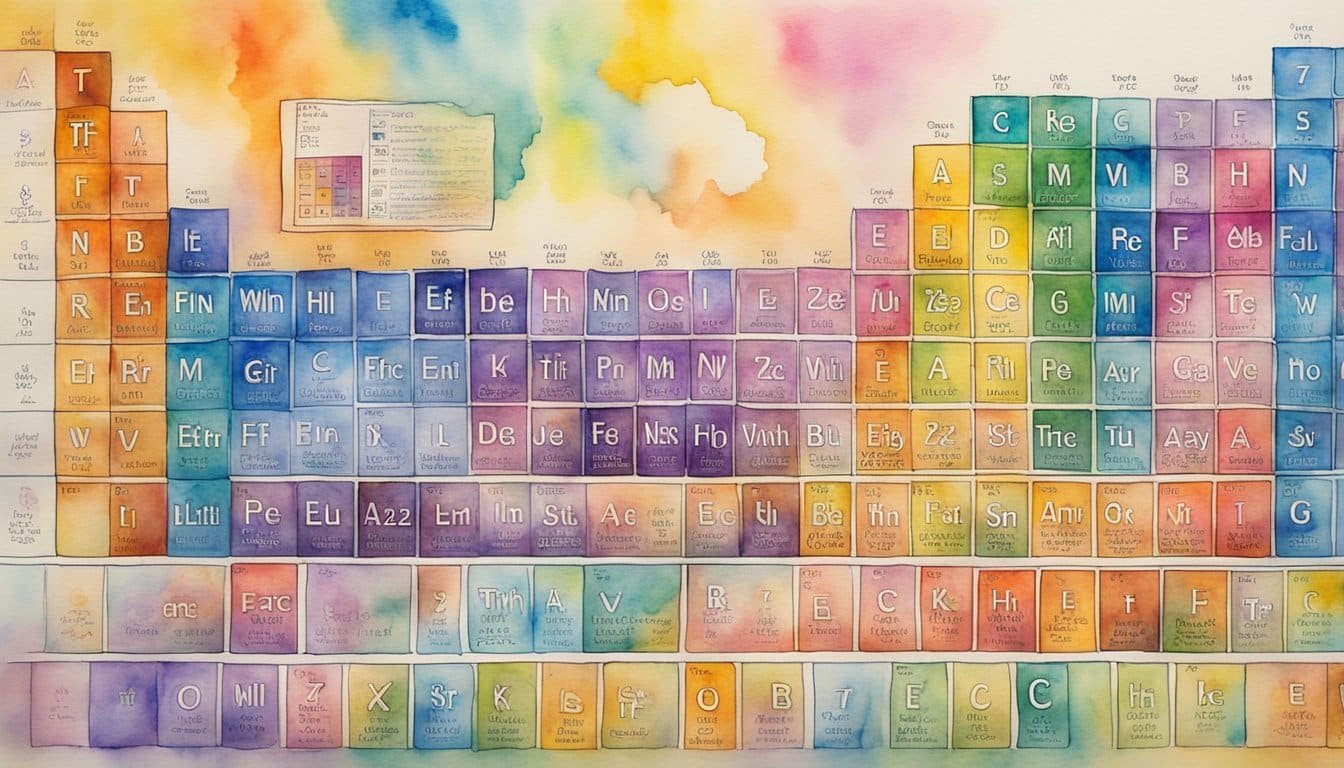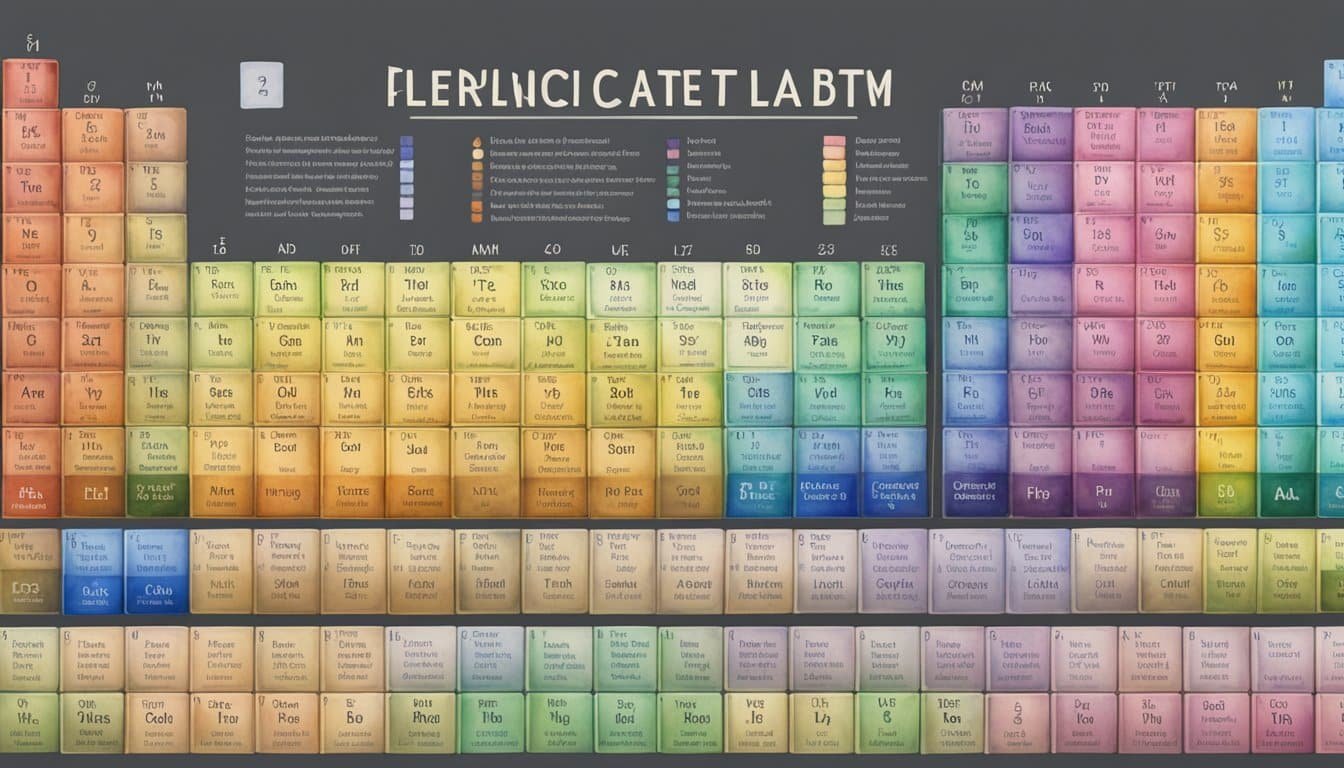Overview of the Periodic Table
The periodic table is a remarkable roadmap to understanding the building blocks that compose our universe. It’s a chart where every chemical element is neatly slotted, highlighting patterns in atomic structure and properties among elements.
Understanding Elements
Every element on the periodic table represents a type of atom with a unique number of protons in its nucleus. This is the atomic number, which not only identifies the element but also gives insight into its chemical behaviors. Elements are organized in ascending order based on this atomic number.
Significance of Atomic Numbers
The atomic number dictates an element’s position on the periodic table, given that periodic law reveals the recurring trends in properties of the elements when they are arranged by increasing atomic number. The significance of this number lies in its utility: it can predict an element’s properties and its reactions with other elements.
Chemical Properties and Groups
Elements on the periodic table are grouped into columns known as groups, which share common chemical properties. This is because they have the same number of electrons in their outermost shell, determining how they interact with other elements. A great way to predict chemical reactions is by understanding an element’s group and the types of bonds it’s likely to form.
Elemental Characteristics

Every element in the periodic table presents a unique set of characteristics that define its state and how it reacts with other elements. These traits are influenced by properties that are atomic and physical in nature.
State and Reactivity
Elements display a range of states at room temperature: hydrogen, for instance, is a gas, while tin appears as a solid. Hydrogen’s reactivity is considerable, easily combining with other elements, whereas tin is relatively more stable and less reactive. How easily an element reacts—its reactivity—is linked to electronegativity, which measures an atom’s ability to attract and bond with electrons. Tin, for instance, has an electronegativity of 1.96, lower than many elements, underscoring its moderate reactivity.
Atomic and Physical Properties
Hydrogen is the lightest element, with an atomic weight of just about 1.008 u (atomic mass units), and naturally, this influences its density too. Density and melting point are fundamental physical properties; tin, for example, has a melting point of 231.93°C and a density of 7.31 g/cm³. The metallic character of an element is also captured by these properties, often correlating with higher densities and melting points. Metallicity declines across the periodic table from left to right, signifying a transition from metals to nonmetals, like the shift from tin’s metallic characteristics to hydrogen’s nonmetallic nature.
Elements also vary widely in terms of atomic weight. Tin, for example, has a notably higher atomic weight of approximately 118.71 u. This, coupled with its other physical properties, reflects its position as a post-transition metal. In the world of the periodic table, where elemental characteristics determine the substance of everything around us, these properties are the ultimate code to understanding material existence.
Specific Element Groups

The periodic table is home to many groups of chemical elements, each with its unique set of properties and characteristics. Within this colorful mosaic, certain groups stand out due to their distinctive behaviors and reactions.
Alkali Metals
Alkali metals, such as lithium, sodium, and potassium, are notorious for their reactivity, especially when they come into contact with water. They are the softest metals, and their vibrant reactions are often showcased in science demonstrations. Lithium, for example, is not only the lightest metal but also plays a vital role in rechargeable batteries for electronic devices and electric vehicles. Sodium, on the other hand, is essential for human nutrition, regulating fluids in the body.
Halogens
Halogens — which include chlorine, bromine, and iodine — are known for their vivid colors and potent reactivity. They are not found freely in nature due to their reactive nature but instead occur as salts when combined with metals. Chlorine is commonly used in water disinfection, while iodine is critical in the production of thyroid hormones in the human body. Bromine finds use in fire retardants and certain types of medication.
Noble Gases and Others
Noble gases such as argon, neon, xenon, and radon have a reputation for being the loners of the periodic table, rarely engaging in chemical reactions because of their full electron shells. This group provides us with a spectrum of applications; for instance, neon lights up striking advertising signs, argon gas protects historical documents, and xenon is used in high-performance flashlights and space exploration propulsion. Despite their inert nature, when noble gases do form compounds, they often produce substances with intriguing properties.

